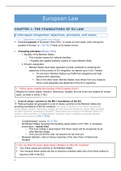Samenvatting
Samenvatting European Law ()
- Vak
- European Law
- Instelling
- Katholieke Universiteit Leuven (KU Leuven)
Volledige samenvatting van het vak European Law gegeven door Elise Muir. Het is een samenvatting van het boek Introduction to the legal EU order, aangevuld met lesnotities en slides. De samenvatting is geschreven in het Engels en telt 78 Pagina's.
[Meer zien]












